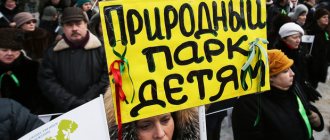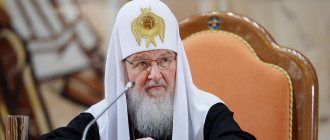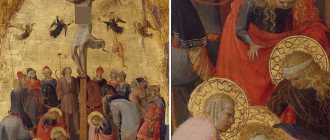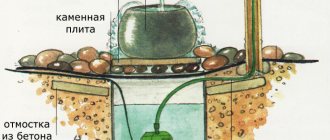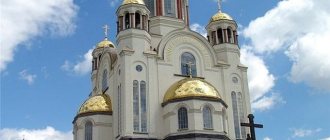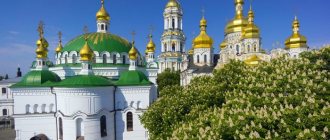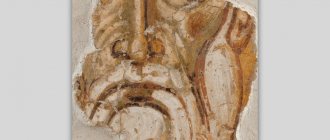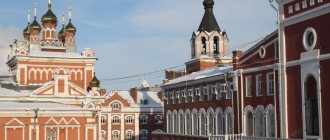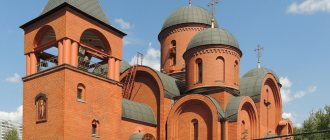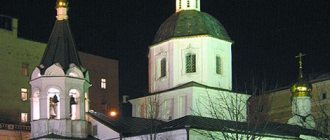The history of the Russian land is invariably connected with the church and worship. Cities arose around the temples and villages were built. Wooden, and later stone buildings, served as a place where people found peace of mind, talked with God, and were equal. Modern mores have changed: shopping and entertainment events have replaced going to church, prayers have become a rarity in the home. But the architecture of church buildings still evokes reverence and awe. Therefore, oil paintings depicting temples are in demand in interior decoration.
Variety of storylines
Golden domes against a background of blue sky, backed by white cumulus clouds, are not the only option when creating such paintings. Temples are the main objects in painting summer, winter, autumn and spring landscapes. The buildings occupy the central or side plan, harmoniously intertwined with the village flavor or urban architecture... In some way, churches are universal in terms of plot. And this makes it easier to find your canvas.
Oil painting “View of GUM” 9000 rub.
Another point is related to the accuracy of the image. Decorating a room with a canvas that captivates with realism means admiring every day the severity of the lines and the variety of details that church buildings are so full of. The sketch, made in the impressionist genre, with slightly blurred outlines and free strokes, has a special magic. It conveys the mood that embodies the awe, solemnity and majesty of these buildings.
Temples of ancient cities in paintings by Russian artists
Ancient Russian cities and towns invariably attracted artists who sought to capture ancient architecture, an atmosphere breathing with antiquity, the rhythm of everyday life taking place against the backdrop of temples and cathedrals, which over the centuries have become silent witnesses to a variety of events. Some of the artists tried to recreate pictures from the past life of old Russian cities. Both historical scenes and contemporary sketches from life in this collection have a mandatory attribute - the domes and crosses of Russian Orthodox churches in all their diversity. The paintings depict ancient cities - Vladimir, Rostov, Pskov, Novgorod, Suzdal, Uglich, Nizhny Novgorod, etc.
Separate collections on the site also include:
Rural temple in paintings by Russian artists >>>
Venerable Sergius of Radonezh and the Trinity-Sergius Lavra >>>
Types of monasteries in Russia >>>
Trips and pilgrimages in Russian painting >>>
Monastic life on the canvases of Russian artists >>>
Golden-domed Moscow in Russian fine art >>>
Temples of the imperial capital in Russian painting >>>
Orthodox faith through the eyes of Russian artists >>>
Assumption Cathedral in Vladimir. Polenov, Vasily Dmitrievich (1844 - 1927). 1860 Paper, pencil. 28 x 18. State Tretyakov Gallery, Moscow
The Assumption Cathedral in Vladimir is an outstanding monument of white stone architecture of pre-Mongol Rus'. Historically, before the rise of Moscow, it was the main (cathedral) church of Vladimir-Suzdal Rus', where the Vladimir and Moscow princes were married for their great reign. A monument of Russian architecture of the 12th century, which served as a model for a number of later cathedrals, including the Assumption Cathedral of the Moscow Kremlin. One of the few churches in which original frescoes by Andrei Rublev have been preserved. Cathedral of the Vladimir Metropolis of the Russian Orthodox Church; now also a state museum. In 1992, the Assumption Cathedral was included in the list of UNESCO World Heritage Sites.
Church of the Intercession on the Nerl. Gerasimov, Sergei Vasilievich (1885 - 1964). 1953 Oil on canvas. State Tretyakov Gallery, Moscow
The Church of the Intercession on the Nerl is an outstanding monument of architecture of the Vladimir-Suzdal school. Located in the Vladimir region of Russia, one and a half kilometers from Bogolyubov. The traditional dating of the temple according to N.N. Voronin is 1165, based on the message of the Life of Andrei Bogolyubsky that the Church of the Intercession was built in memory of the deceased son of the Grand Duke, Izyaslav Andreevich. Modern researchers S.V. Zagraevsky and T.P. Timofeev, based on chronicle information, substantiate the earlier date of the temple - 1158. The white stone Church of the Intercession was built on a man-made hill. The usual strip foundation, laid at a depth of 1.6 m, is continued by the base of the walls, 3.7 m high, which were covered with clay soil of an embankment, lined with white stone. According to the Laurentian Chronicle, construction under Prince Andrei was carried out “by masters from all lands.” Tatishchev clarifies in “Russian History” that “the masters were sent from Emperor Frederick the First, with whom Andrei was on friendly terms...” (meaning Frederick Barbarossa). The church was consecrated in honor of the Feast of the Intercession of the Virgin Mary, established in Rus' in the middle of the 12th century on the initiative of Andrei Bogolyubsky. This is probably the first Church of the Intercession in Rus'.
Church. Nesterov, Mikhail Vasilievich (1862 - 1942). 1896-1942 Paper, watercolor, graphite pencil. Sketch. Private collection
The past. Goryushkin-Sorokopudov, Ivan Silych (1873 - 1954). 1910 Cardboard, tempera. 47 x 76. State Museum of Fine Arts of the Republic of Tatarstan, Kazan Inv. number: Ж-646
Russian fortified city of the 15th-16th centuries. Izmailovich, Vladislav Matveevich (1872 - 1959). 1936 Oil on canvas. 90 x 148. Military Historical Museum of Artillery, Engineering Troops and Signal Corps, St. Petersburg
Old Russian city. Vasnetsov, Apollinariy Mikhailovich (1856 - 1933). Canvas, oil. Arkhangelsk Regional Museum of Fine Arts
Square in front of the church. Street in the city. Vasnetsov, Apollinariy Mikhailovich (1856 - 1933). 1911 Sketch. Paper, watercolor, charcoal. 57 x 87. State Central Theater Museum named after. A.A.Bakhrushina, Moscow
Bargaining in Nizhny Novgorod. Vasnetsov, Apollinariy Mikhailovich (1856 - 1933). 1908-1913 Paper, watercolor. Sevastopol Art Museum named after. M.P. Kroshitsky
View of Nizhny Novgorod Bogolyubov, Alexey Petrovich (1824 - 1896). Canvas, oil. 48 x 73. Sketch for the painting of the same name State Russian Museum, St. Petersburg
View of Nizhny Novgorod. Bogolyubov, Alexey Petrovich (1824 - 1896). 1878 Oil on canvas. 155 x 245 cm State Russian Museum, St. Petersburg
View of Nizhny Novgorod. Levitan, Isaac Ilyich (1860 - 1900). Early 1890s. Canvas, oil. 9 x 14 cm Novokuznetsk Art Museum, Kemerovo region.
Nizhny Novgorod. Lower bazaar. Bogolyubov, Alexey Petrovich (1824 - 1896). Canvas, oil. 31 x 49. State Russian Museum, St. Petersburg
Market in Nizhny Novgorod. Vereshchagin, Pyotr Petrovich (1834 - 1886). 1867 Oil on canvas. 66 x 106 cm Nizhny Novgorod State Art Museum
Market in Nizhny Novgorod. Vereshchagin, Pyotr Petrovich (1834 - 1886). 1872 Oil on canvas. 90 x 140 cm State Tretyakov Gallery, Moscow
Minin on Nizhny Novgorod Square, calling on people for donations. Makovsky, Konstantin Egorovich (1839 - 1915). 1890s. Canvas, oil. 273 x 233 cm State Russian Museum, St. Petersburg
On the square near the Ivanovo Congress of the Nizhny Novgorod Kremlin. Makovsky, Konstantin Egorovich (1839 - 1915). 1890s. Canvas, oil. 55 x 63. Study for the 1896 painting “Minin on Nizhny Novgorod Square, calling on people for donations.” Arkhangelsk Regional Museum of Fine Arts
View of Nizhny Novgorod. Chernetsov, Nikanor Grigorievich (1805-1879). 1837 Oil on canvas, 51 x 71 cm Historical, Architectural and Art Museum “New Jerusalem”
View of the Volga near Nizhny Novgorod. Makovsky, Nikolai Egorovich (1841-1886). 1878 Oil on canvas. 69.8 x 59.7. Yaroslavl Art Museum
Nizhny Novgorod. Orlovsky, Vladimir Donatovich (1842 - 1914). Canvas, oil. Rybinsk State Historical, Architectural and Art Museum-Reserve, Yaroslavl region.
Nizhny Novgorod. Lentulov, Aristarkh Vasilievich (1882 - 1943). 1915 Oil on canvas, bronze. 107 x 125. State Tretyakov Gallery, Moscow
Winter. Thaw. Gorbatov, Konstantin Ivanovich (1876 - 1945). 1910 Oil on canvas. 111 x 138. Sevastopol Art Museum named after. M.P. Kroshitsky Inv. number: Ж-231
Russian province in spring. Gorbatov, Konstantin Ivanovich (1876 - 1945). 1922 Oil on canvas. 74 x 90. Private collection
Early spring. City on the river. Gorbatov, Konstantin Ivanovich (1876 - 1945). 1915-1916 Canvas, oil. Private collection
Landscape with churches. Gorbatov, Konstantin Ivanovich (1876 - 1945). Paper, watercolor, pencil. 46 x 38. Private collection
Winter landscape with a church. Gorbatov, Konstantin Ivanovich (1876 - 1945). 1925 Oil on canvas. 91 x 121. Historical, architectural and art museum “New Jerusalem”, Istra, Moscow region. Inv. number: ZhG-33
Pskov. Gorbatov, Konstantin Ivanovich (1876 - 1945). 1905 Oil on canvas. Private collection
Old Pskov. Gorbatov, Konstantin Ivanovich (1876 - 1945). 1913 Cardboard, tempera. 70 x 89. Saratov State Art Museum named after. A.N. Radishcheva
Winter evening. Pskov. Gorbatov, Konstantin Ivanovich (1876 - 1945). 1910 Paper, gouache. Private collection
View of Pskov under the snow. Gorbatov, Konstantin Ivanovich (1876 - 1945). 1922 Oil on canvas. 23 x 31. Private collection
Early spring. Pskov. Gorbatov, Konstantin Ivanovich (1876 - 1945). 1922 Oil on canvas. 58 x 70. Arkhangelsk Regional Museum of Fine Arts
Autumn in Pskov. Gorbatov, Konstantin Ivanovich (1876 - 1945). 1930s. Cardboard, oil. 49 x 59. Historical, architectural and art museum “New Jerusalem”, Istra, Moscow region.
Pskov. Moorings. Gorbatov, Konstantin Ivanovich (1876 - 1945). 1919 Oil on canvas. Private collection
Pskov (Life on the Pskov River). Gorbatov, Konstantin Ivanovich (1876 - 1945). 1919 Cardboard, oil. 48 x 62. Private collection
Pskov. Gorbatov, Konstantin Ivanovich (1876 - 1945). 1930s. Canvas, oil. 45 x 60 cm Private collection
Pskov. 1930s (?) Gorbatov, Konstantin Ivanovich (1876 - 1945). Canvas, oil. 79 x 100. Historical, architectural and art museum “New Jerusalem”, Istra, Moscow region. Inv. number: ZhG-74
View of Pskov. Gorbatov, Konstantin Ivanovich (1876 - 1945). 1915 Oil on canvas. Private collection
View of Pskov. Sunset. Gorbatov, Konstantin Ivanovich (1876 - 1945). 1919 Oil on canvas. Private collection
Fish market in Pskov Gorbatov, Konstantin Ivanovich (1876 - 1945). Cardboard, gouache. 63 x 48. Private collection
Pskov. View of the Kremlin and Trinity Cathedral from the Pskov River. Vereshchagin, Pyotr Petrovich (1834-1886). 1870s. Oil on canvas, 38 x 76. State Tretyakov Gallery
View of Pskov. Dobuzhinsky, Mstislav Valerianovich (1875 - 1957). Paper, gouache, charcoal. 23 x 29. Private collection
Winter in Pskov. Lakhovsky, Arnold (Aaron) Borisovich (Berkovich) (1880-1937). 1927 Wood, oil on canvas. 51 x 66. Private collection
Pskov. Lakhovsky, Arnold (Aaron) Borisovich (Berkovich) (1880-1937). 1914 Cardboard, oil. 67 x 51. Donetsk Regional Art Museum
View from the shore of Pskov to the Church of the Epiphany. Lakhovsky, Arnold (Aaron) Borisovich (Berkovich) (1880-1937). 1922 Oil on cardboard, 46.8 x 61 Private collection
The first chronicle mention of the Church of the Epiphany from Zapskovye dates back to 1398. Then the church was wooden, and burned down during the great fire of 1458. Construction of the stone building that now exists was completed by 1496. Once upon a time, the Church of the Epiphany from Zapskovye was the center of a large region of Zapskovye - the Epiphany end. It was one of the largest churches in Konchan, and later in all of Pskov. The Church of the Epiphany has reached ours practically unchanged, retaining its original forms, although it was rebuilt more than once, closed during the Soviet era, and damaged during the Great Patriotic War. In the 1990s, restoration work began on the church. In 2005, the temple was transferred to the jurisdiction of the Pskov diocese.
Pskov. Belfry. Stozharov, Vladimir Fedorovich (1926 - 1973). 1969 Oil on canvas. 90 x 121. Taganrog Art Museum
Pskov. Church of the Intercession. Stozharov, Vladimir Fedorovich (1926 - 1973). Canvas, oil.
Boats off the shore. Pskov. Yuon, Konstantin Fedorovich (1875 - 1958). 1904 Paper, watercolor, whitewash. 30 x 22. Museum-apartment of I.I. Brodsky, St. Petersburg
Ice drift in Pskov. Brodsky, Isaac Izrailevich (1883 - 1939). 1913 Cardboard, oil. 34 x 42. State Vladimir-Suzdal Historical, Architectural and Art Museum-Reserve
Old Pskov. Roerich, Nikolai Konstantinovich (1874 - 1947). 1922 Tempera on canvas. 51 x 76. Set design for N.A. Rimsky-Korsakov’s opera “The Woman of Pskov”. N. Roerich Museum, New York, USA
Assumption Paromenskaya Church in Pskov. Roerich, Nikolai Konstantinovich (1874 - 1947). Early 1900s.
Pskov churchyard. Roerich, Nikolai Konstantinovich (1874 - 1947). 1904
Yaroslavl. Church of the Nativity of Christ. Roerich, Nikolai Konstantinovich (1874 - 1947). 1903 Plywood, oil. 30 x 40.
“The artist spent part of the past summer traveling to western and central Russia, visiting Yaroslavl, Kostroma, Nizhny, Yuryev-Polsky, Vladimir, Suzdal, Rostov the Great, Smolensk, Vilna, Troki, Grodno, Kovno, Merech, Riga, Wenden, in Pechory, Izborsk and Pskov. The purpose of this trip was to bring onto the canvas monuments of ancient architecture, some of which were already crumbling and even destroyed. N.K. Roerich was helped by his wife, working with a photographic apparatus.” Rus. 1904. January 8/21. No. 27
Yaroslavl. Church of St. Blaise. Roerich, Nikolai Konstantinovich (1874 - 1947). 1903 Plywood, oil. 39 x 31.
Yaroslavl. Entrance to the Church of St. Nicholas the Mokroy. Roerich, Nikolai Konstantinovich (1874 - 1947). 1903 Plywood, oil. 31 x 40.
Yaroslavl. Church of St. Nicholas the Mokroy. Portal. Roerich, Nikolai Konstantinovich (1874 - 1947). 1903 Plywood, oil.
Yaroslavl. Interior of the Church of the Epiphany. Roerich, Nikolai Konstantinovich (1874 - 1947). 1903 Plywood, oil. 40 x 31.
View of the city of Yaroslavl. Chernetsov, Nikanor Grigorievich (1805-1879). 1860 Oil on canvas, 75 x 107 cm State Russian Museum
Thaw. Yaroslavl. Savrasov, Alexey Kondratievich (1830 - 1897). 1874 Oil on canvas. 53 x 75 cm State Russian Museum, St. Petersburg
View of Yuryevets Povolsky Chernetsov, Nikanor Grigorievich (1805-1879). 1851 Oil on canvas, 72 x 106 cm Source: State Russian Museum Yuryevets is the oldest city in the Ivanovo region. It is believed that it was founded in the first half of the 13th century - as a fortification to protect the eastern borders of North-Eastern Rus' by the Grand Duke of Vladimir Yuri II on the site of the appearance of the icon of the Great Martyr George the Victorious to him and was named in honor of this saint George - Yuriev-Povolsky.
Kostroma. Chernetsov, Nikanor Grigorievich (1805-1879). 1862 Oil on canvas, 102 x 151 Kharkov Art Museum
Entrance door to the Ipatiev Cathedral in Kostroma. Vereshchagin, Vasily Vasilievich (1842-1904). 1890 Oil on canvas, 35 x 27 Private collection
Yuriev-Polsky. St. George's Cathedral. Roerich, Nikolai Konstantinovich (1874 - 1947). 1903 Plywood, oil. 31 x 39.
Yuriev-Polsky. St. George's Cathedral. Roerich, Nikolai Konstantinovich (1874 - 1947). 1903 Plywood, oil. 40 x 31.
Uglich. Church of Tsarevich Dmitry. Roerich, Nikolai Konstantinovich (1874 - 1947). 1904 Plywood, oil.
Uglich. Porch of the Church of John the Baptist. Roerich, Nikolai Konstantinovich (1874 - 1947). 1904 Plywood, oil.
Putivl. Roerich, Nikolai Konstantinovich (1874 - 1947). 1908 Paper on cardboard, pastel, graphite pencil, tempera, charcoal pencil. 48 x 63. Set design for A.P. Borodin’s opera “Prince Igor”. State Tretyakov Gallery, Moscow
Putivl. Roerich, Nikolai Konstantinovich (1874 - 1947). 1914 Cardboard, tempera. 68 x 96. Sketch of the set of the opera by A.P. Borodin "Prince Igor". Private collection
Zvenigorod. Roerich, Nikolai Konstantinovich (1874 - 1947). 1933 Tempera on canvas. 46 x 79. N. Roerich Museum, New York, USA
Zvenigorod. Kryzhitsky, Konstantin Yakovlevich (1858 - 1911). 1895 Oil on canvas. Arkhangelsk Regional Museum of Fine Arts
Sunset. Kryzhitsky, Konstantin Yakovlevich (1858 - 1911). Canvas, oil. 21 x 35 cm Tyumen Regional Museum of Fine Arts
View of Zvenigorod. Rabus, Karl Ivanovich (1800 - 1857). Second quarter of the 19th century. Canvas, oil. 49 x 77 cm State Tretyakov Gallery, Moscow
Zvenigorod. Kondratenko, Gavriil Pavlovich (1854 - 1924)
Church of the Nativity of the Virgin Mary. Zvenigorod. Zhukovsky, Stanislav Yulianovich (1873-1944). 1904 Oil on canvas. 82.8 x 82 Nizhny Tagil Art Museum of Fine Arts
General view of Rostov the Great. Willie, Mikhail Yakovlevich (1838 - 1910). Paper, watercolor.
Spring evening. Rostov the Great. Yuon, Konstantin Fedorovich (1875-1958). 1906 Oil on canvas. 70 x 96 cm Serpukhov Historical and Art Museum, Moscow region.
Rostov cathedrals. Yuon, Konstantin Fedorovich (1875-1958). 1906 Paper, watercolor, white 22.7 x 30.4 Private collection
Rostov the Great. Roerich, Nikolai Konstantinovich (1874 - 1947). 1903 Study. Wood, oil. 31 x 41 cm State Tretyakov Gallery, Moscow
Rostov the Great. Entrance to the Kremlin. Roerich, Nikolai Konstantinovich (1874 - 1947). 1903 Plywood, oil. 40 x 31.
Rostov the Great. Church of St. John the Evangelist. Roerich, Nikolai Konstantinovich (1874 - 1947). 1903 Cardboard, oil. 45 x 35. State Russian Museum, St. Petersburg
Rostov the Great. Church on Ishna. Roerich, Nikolai Konstantinovich (1874 - 1947). 1903 Plywood, oil.
Interior view of the Church of St. John the Evangelist on Ishna near Rostov-Yaroslavsky. Vereshchagin, Vasily Vasilievich (1842-1904). 1888 Oil on canvas, 60 x 45 State Russian Museum
Iconostasis of the Church of St. John the Evangelist on Ishna near Rostov-Yaroslavsky. Vereshchagin, Vasily Vasilievich (1842-1904). 1888 Oil on canvas. 60 x 45 cm State Russian Museum
Rostov the Great. Church of the Savior on Senya. Roerich, Nikolai Konstantinovich (1874 - 1947). 1903 Plywood, oil. 31 x 41.
Rostov the Great. Church of the Savior on Senya. Roerich, Nikolai Konstantinovich (1874 - 1947). 1903 Plywood, oil. 40 x 31.
Rostov the Great. Church of the Savior on Senya. Roerich, Nikolai Konstantinovich (1874 - 1947). 1903 Plywood, oil. 31 x 41 cm
Rostov the Great. Porch. Roerich, Nikolai Konstantinovich (1874 - 1947). 1903 Plywood, oil. 39 x 30.
Belfry of the Pskov-Pechersky Monastery (XVI century). Makovsky, Alexander Vladimirovich (1869-1924). 1911 Oil on canvas. 40 x 55. Zaporozhye Art Museum, Ukraine The painting is attributed to the bell tower of the Pskov-Pechersk Monastery. In fact, the artist depicted the Rostov belfry.
Rostov the Great. Goryushkin-Sorokopudov, Ivan Silych (1873 - 1954). 1910s. Paper on cardboard, gouache. 50x71. Penza Regional Art Gallery named after. K.A. Savitsky
Winter. Rostov Kremlin. Goryushkin-Sorokopudov, Ivan Silych (1873 - 1954). 1910s. Canvas, oil. 72 x 70. Penza Regional Art Gallery named after. K.A. Savitsky
Rostov in winter. Petrovichev, Pyotr Ivanovich (1874 - 1947). 1910 Cardboard, tempera, gouache. 70 x 98. State Museum-Reserve "Rostov Kremlin", Rostov, Yaroslavl region.
Rostov the Great. Petrovichev, Pyotr Ivanovich (1874 - 1947). Cardboard, tempera. 70 x 141. Sevastopol Art Museum named after. M.P. Kroshitsky Inv. number: G-717
Corner of the Rostov Kremlin. Petrovichev, Pyotr Ivanovich (1874 - 1947). 1899 Oil on canvas. 51 x 69. Kiev National Museum of Russian Art, Ukraine Inv. number: Ж-1156
Shopping arcades near the Rostov Kremlin. Kalmykov, Ivan Leonidovich (1866-1925). Beginning of the 20th century. Oil on canvas, 75 x 110. State Museum-Reserve "Rostov Kremlin"
Rostov the Great. On the lake. Gorbatov, Konstantin Ivanovich (1876 - 1945). 1943 Oil on canvas. 59 x 79. Historical, architectural and art museum “New Jerusalem”, Istra, Moscow region. Inv. number: ZhG-82
Novgorod the Great. Gorbatov, Konstantin Ivanovich (1876 - 1945). 1910s. Tinted paper on cardboard, gouache, whitewash. 47 x 58. Historical, architectural and art museum “New Jerusalem”, Istra, Moscow region. Inv. number: GG-88
Novgorod. Pier. Gorbatov, Konstantin Ivanovich (1876 - 1945). 1919 Cardboard, oil. 38 x 54. State Vladimir-Suzdal Historical, Architectural and Art Museum-Reserve. Inv. number: B-38033
Pier in the old town. Gorbatov, Konstantin Ivanovich (1876 - 1945). 1913 Paper on cardboard, watercolor, gouache. 48 x 65. Private collection
Old Novgorod. Barges. Gorbatov, Konstantin Ivanovich (1876 - 1945). 1913 Oil on canvas. 107 x 142. Private collection
Velikiy Novgorod. Gorbatov, Konstantin Ivanovich (1876 - 1945). 1919 Oil on canvas. Private collection
Varangian ships in Veliky Novgorod. Vasnetsov, Apollinariy Mikhailovich (1856 - 1933). 1902 Oil on canvas. 101 x 99. Private collection
Marina in Novgorod. Korovin, Konstantin Alekseevich (1861 - 1939). 1906 Sketch of the set for N.A. Rimsky-Korsakov’s opera “Sadko” State Historical, Artistic and Literary Museum-Reserve “Abramtsevo”, Moscow region.
Novgorod the Great (Yaroslav's courtyard, Vechevaya tower). Dobuzhinsky, Mstislav Valerianovich (1875-1957). Before 1917. Cardboard, watercolor, 24x30. Samara Regional Art Museum
Reproduction of watercolor by M.V. Dobuzhinsky on a postcard “in favor of the Society of St. Evgenia"
M.V. Dobuzhinsky was born on August 2, 1875 in Veliky Novgorod on Prusskaya Street in the house of his maternal grandfather, priest Timofey Yegorovich Sofiysky. His son's eldest daughter Elizaveta Egorovna in 1869 became the wife of Lieutenant Valerian Petrovich Dobuzhinsky of the Life Guards Horse Artillery. “...At baptism I was named Mstislav in honor of Mstislav the Brave, the holy prince of Novgorod, who lived in the 12th century...” (M.V. Dobuzhinsky “Memoirs”, volume 1, New York, 1976). As a child, the artist came every summer from St. Petersburg to Novgorod to visit his grandparents, and then, as an adult, he painted Sofia with a dove on the cross, Sennaya Square, and Yaroslav’s Courtyard. He noted that he grew up in Novgorod among legends, and the antiquity surrounding him was perceived by him as a shrine. The last time Dobuzhinsky visited Novgorod was in 1914 on the eve of the First World War. After the revolution, I never came there again in order to keep the city in my memory unchanged. The picture shows the Vechevaya Tower of Yaroslav's Courtyard (the artist depicted only one passage arch, in pre-revolutionary photos there was also one, currently there are two), also known as the Gate Tower of Gostiny Dvor, built in 1686. On the right side of it you can see the bell tower, built in the 17th century. It was erected opposite the Nikolsky (Nikolo-Dvorishchensky) Cathedral, near the walls of which the veche had gathered since the beginning of the 13th century. Perhaps, on the site of the Gate Tower there once stood a tower with a veche bell and a veche office, so the name Veche Tower was fixed and was used before the revolution. Even further to the right of the bell tower you can see the dome of the Church of the Myrrh-Bearing Women (1508-1511). This church was built by merchant Ivan Syrkov, a settler from Moscow, on the site of an older burnt temple. Its lower floors and basement housed warehouses in which part of Ivan the Terrible's treasury was at one time kept. Complex engineering solutions were used during construction: a system of internal staircases, window shafts in the walls to illuminate the basement, metal connections for the strength of the walls, hidden behind monumental and monolithic facades, all this betrays the hand of an experienced architect. Perhaps foreign masters or their Russian students from Moscow lands were invited. But externally the temple was made in the traditional Novgorod style. In later years it was remade several times. In the late 1950s and early 60s, the temple was restored in 16th-century forms.
Novgorod. Sofia. Konchalovsky, Pyotr Petrovich (1876 - 1956). 1925 Oil on canvas. 90 x 117 cm National Gallery of Art. Boris Voznitsky, Lviv, Ukraine Inv. number: Ж-3585
Painting in the Church of the Savior in Nereditsa in Novgorod. Alexander Vladimirovich Makovsky. 1913 Oil, cardboard. Ecclesiastical and archaeological office of the Moscow Theological Academy, Sergiev Posad
The Church of the Savior on Nereditsa was built in 1198 by Prince Yaroslav Vladimirovich. The last palace princely church of Novgorod. It was slightly rebuilt under the pseudo-Byzantine style during restoration in 1904; the bell tower was lost during the Great Patriotic War. Now restored to its original form. The frescoes have been partially preserved. UNESCO monument.
Spas Nereditsa (Ancient Novgorod). Roerich, Nikolai Konstantinovich (1874 - 1947). 1935-1936 Cardboard, tempera. 30 x 45. Private collection The Church of the Savior on Mount Nereditsa is the Church of the Transfiguration of the Lord, located 1.5 km south of Veliky Novgorod on the right bank of the former riverbed of the Maly Volkhovets, on a small hill next to the Rurik Settlement. Erected in 1198 under the Novgorod prince Yaroslav Vladimirovich. The temple is famous for its frescoes. Included in the UNESCO World Heritage List.
Saved Nereditsy in Novgorod. Roerich, Nikolai Konstantinovich (1874 - 1947). 1894 Coal, cardboard. Ecclesiastical and archaeological office of the Moscow Theological Academy, Sergiev Posad
Novgorod Pogost (Northern Rus'). Roerich, Nikolai Konstantinovich (1874 - 1947). 1943 Cardboard, tempera. 31 x 46. State Russian Museum, St. Petersburg
March. Church in Novgorod. Gerasimov, Sergei Vasilievich (1885-1964). 1930-1940s. Canvas, oil. 62.6x87.8
Novgorod Church. Ryabushkin, Andrey Petrovich (1861 - 1904). 1903 Cardboard, gouache. 31 x 48. State Russian Museum, St. Petersburg
Mikhailovskaya street in Novgorod. Ryabushkin, Andrey Petrovich (1861 - 1904). 1899 Study. Canvas, oil. 13 x 21. State Tretyakov Gallery, Moscow Inv. number: 4842
Winter morning. Ryabushkin, Andrey Petrovich (1861 - 1904). 1903 Cardboard, gouache. 21 x 43. Research Museum of the Russian Academy of Arts, St. Petersburg
Hawthorn Walk. Ryabushkin, Andrey Petrovich (1861 - 1904). 1893 Oil on canvas Arkhangelsk Regional Museum of Fine Arts
Nikolo-Zaryadskaya Church. Kulikov, Ivan Semenovich (1875 - 1941). 1916 Oil on canvas. Murom Historical and Art Museum, Vladimir region. The Nikolo-Zaryadskaya Church stood behind the shopping arcades in the center of Murom. It was built in the 70s of the 17th century. On the church there were crosses with crowns at the top and N.G. Dobrynkin assumed that the temple was built with the sovereign's money.
Street of old Murom. Kulikov, Ivan Semenovich (1875 - 1941). Canvas, oil. Murom Historical and Art Museum, Vladimir region.
Moore. Arkhipov (Pyrikov) Abram Efimovich (1862-1930). 1910 Oil on canvas, 74 x 89. Private collection
Uglich. Alexander Vladimirovich Makovsky. 1910 Oil, cardboard. Ecclesiastical and archaeological office of the Moscow Theological Academy, Sergiev Posad
Ascension Cathedral in Uglich, 17th century. Alexander Vladimirovich Makovsky. 1910 Oil, cardboard. Ecclesiastical and archaeological office of the Moscow Theological Academy, Sergiev Posad
Morning in Uglich. Yuon, Konstantin Fedorovich (1875-1958). 1913 Oil on canvas. 71 x 89.5. Museum-apartment of I.I. Brodsky
Market square in Uglich. Yuon, Konstantin Fedorovich (1875-1958). 1913 Paper, watercolor, whitewash, 52×69 From the collection of A.V. Kasyanov Omsk Regional Museum of Fine Arts named after M.A. Vrubel Inventory number 11913
Troika in Uglich. Yuon, Konstantin Fedorovich (1875-1958). 1913 Paper, watercolor, whitewash. 53x69. State Russian Museum
Ancient city of Uglich. Yuon, Konstantin Fedorovich (1875-1958). 1913 The painting was presented at the Museum of Architecture. A.V. Shchusev at the Sotheby's pre-auction exhibition on October 25-26, 2021. Photo: Sotheby's
In the province. City of Torzhok. Yuon, Konstantin Fedorovich (1875-1958). Canvas, oil. 75 x 111. Kaluga Regional Art Museum
Torzhok. Yuon, Konstantin Fedorovich (1875-1958). 1914 Oil on canvas. 71 x 108 cm Chuvash State Art Museum, Cheboksary
Torzhok. Gorbatov, Konstantin Ivanovich (1876 - 1945). 1917 Oil on canvas. 82 x 137 cm Gorlovka City Art Museum, Donetsk region.
In old Suzdal. Kustodiev, Boris Mikhailovich (1878 - 1927). Canvas, oil.
On the Volga. Landscape with the Transfiguration-Kazan Church. Romanov-Borisoglebsk Kustodiev, Boris Mikhailovich (1878 - 1927). Cardboard, colored pencil, pastel. 71 x 98. Private collection
Partying. Kustodiev, Boris Mikhailovich (1878 - 1927). 1910 Oil on canvas, tempera. 160 x 214 cm Kostroma State Historical, Architectural and Art Museum-Reserve The painting supposedly depicts the Cathedral of the Resurrection of Christ in Tutaev (formerly Romanov-Borisoglebsk).
On the Volga. Kustodiev, Boris Mikhailovich (1878 - 1927). 1910 Cardboard, oil. 27 x 27. Private collection
Twilight in Sudislavl Kustodiev, Boris Mikhailovich (1878 - 1927). Canvas, oil. 25 x 38. Kostroma State Historical, Architectural and Art Museum-Reserve The painting depicts the Cathedral of the Transfiguration and the Church of St. Nicholas the Wonderworker (lost)
Fair. Kustodiev, Boris Mikhailovich (1878 - 1927). 1906 Paper on cardboard, graphite, tempera. 66 x 88. State Tretyakov Gallery, Moscow The painting depicts Market Square in Kineshma
Street in a provincial town. Kustodiev, Boris Mikhailovich (1878 - 1927). 1917 Sketch. Paper, graphite pencil, gouache. 18 x 22. Private collection
On the Volga. Lakhovsky, Arnold Borisovich (1880 - 1937). 1918 Oil on canvas. 81 x 101. Art Museum, Cherepovets, Vologda region.
Vologda. Vereshchagin, Vasily Vasilievich (1842-1904). 1893-1894 Oil on canvas on cardboard 18 × 22 Vologda Regional Art Gallery
Vyatka. Khokhryakov, Nikolai Nikolaevich (1857-1928). 1886 Oil on canvas, 44.7 x 76 cm State Tretyakov Gallery
Fallen bells. Goryushkin-Sorokopudov, Ivan Silych (1873 - 1954). 1930s. Cardboard, gouache. 71 x 52. Penza Regional Art Gallery named after. K.A. Savitsky Perhaps the pink wall on the left indicates that the dramatic canvas, symbolizing the end of old Russia, was written based on the author’s Rostov impressions and echoes the Rostov belfry so beloved by the author.
Looking for the perfect place
Temples are a symbol of purity, inviolability and tranquility. Their images create a peaceful atmosphere around. Therefore, it is preferable to place paintings with churches or monasteries in rooms where it is planned to arrange a resting place. Canvases are relevant in the design of the living room and bedroom. They will also be useful in the decor of your personal office. Hang them above the sofa or opposite the desk so that the sketch is always before your eyes.
Oil painting “In St. Petersburg” 15,500 rub.
When buying oil paintings with temples, consider the style of the interior. They are most in demand in the classics. The sophistication of the design, combined with the correct geometry of the architecture depicted on the canvas, looks magnificent and elegant. A suitable frame with figured elements or without decor will complement the picture.
It doesn’t matter what format or size you purchase a canvas with a church or monastery. The main thing is that it gives a feeling of calm and harmony, which is so lacking in the modern world. In our catalog you can look and choose the painting that is closest to the plot and bring a little warmth and comfort to your home.
